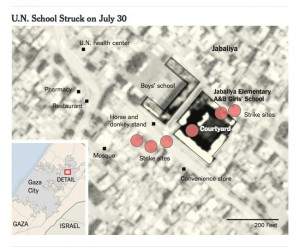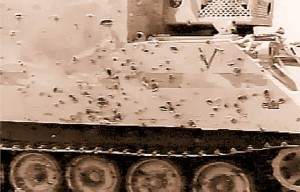Issue a retraction, Human Rights Watch
December 4, 2023 by Thomas Wictor
The corrupt, Jew-hating non-governmental organization (NGO) Human Rights Watch claims that Israel committed a war crime by attacking the United Nations Relief Works Agency (UNRWA) Elementary Girls School A and B at Jabalia on July 30, 2014. For this assessment they relied on “investigator” Fred Abrahams, who has no background in the military or weaponry.
Fred’s bio says that he’s a Special Adviser, Children’s Rights Division. He has a bachelor’s degree in German and International Studies—a course I didn’t know was offered—and a master’s degree in International Affairs. Here’s what he said about three alleged Israeli attacks on schools.
This means that people were taking shelter, killing, and wounding civilians in the schools. Fred also claims that people went to the schools for protection and carnage.
Fred often gets in trouble when commenting on weapons for Human Rights Watch, as happened in 2009.
So according to Fred, the IDF fired smoke shells when its troops weren’t in the area. This is prima facie evidence that Fred hasn’t the slightest clue what he’s talking about. Smoke shells are only used to cover troop movements. The IDF would never fire smoke shells if there were no troops in the area. Also, the M825A1 smoke shell can’t burn people to death or start fires. The felt wedges that are impregnated with white phosphorus go out in seconds.
Although the IDF would never agree to do this, I’d stand in a field and let them fire an M825A1 smoke shell set to explode over my head. The reason they wouldn’t do this is because I might be hit by the steel casing of the shell, but the felt wedges can’t burn anything.
Human Rights Watch is conflating smoke shells and weaponized white phosphorus. Not a single Palestinian was burned by an M825A1 smoke shell.
The attack on the school at Jabalia
Human Rights Watch presents a version of events that’s insane.
Suleiman Hassan Abd el-Dayam, 24, was staying in the school with his wife, his sisters, and his sisters’ families. He said he and the other men were sleeping in the courtyard while women and children were sleeping in the classrooms. About 2 a.m. he went to the bathroom, a small building on the far side of the courtyard from the main school building. While he was there, he said, a small “warning missile,” which did not explode, hit the bathrooms section of the courtyard. The Israeli military has acknowledged firing small missiles without explosive warheads as a warning before an attack. Palestinian forces have no record of doing this. El-Dayam returned to the courtyard and took shelter in the school buildings. He went into one of the classrooms with his wife and children. Shortly before 5 a.m., he said, a second munition hit.
1. The “knock on the roof”—firing a small munition with no explosive warhead as a warning—is not used when engaging combatants. Making the claim that a small munition was fired first is an attempt by Palestinians and Human Rights Watch to reframe this incident as a deliberate IDF attack on a school. Also, the knock is used to warn of air strikes, not artillery barrages.
2. The knock on the roof came three hours before the alleged attack. There’s never a three-hour lag between the knock and the strike, because that could convince residents that an attack was not about to happen, and they might go back inside.
3. After acknowledging the warning, the Palestinian man went back inside to go to sleep, knowing that an air strike was imminent. He didn’t try to evacuate his family.
4. Human Rights Watch says that Palestinians have no record of using the knock on the roof. This is sheer stupidity. Palestinians have a long history of adopting Israeli methods in order to carry out deception operations.
I never bother analyzing Palestinian eyewitness accounts. They’re worthless. So are the reports that Human Rights Watch publishes.
Why would the Israelis fire illumination rounds and smoke shells at a school? The IDF uses illumination rounds to light the way for advancing troops. Smoke shells conceal the movement of those troops. There was no ground assault against the Jabalia school, so the IDF would not have used illumination or smoke shells.
As for high-explosive shells, the New York Times says there were six impacts.
But the damage at Jabalia is completely inconsistent with 155mm high-explosive artillery shells. These shells explode into 2000 jagged fragments. The following video gives you an idea of what a 155mm high-explosive shell does.
At Jabalia, we had this damage.
The school was hit with heavy machine guns, grenade launchers, mortars, rocket-propelled grenades, and recoilless rifles. You know how I know?
Because now I have a video of buffoonish Russian “special forces” using most of those weapons on a school.
A giant hole from a rocket-propelled grenade (RPG).
Virtually all of the siding has been shot off, and the Russians appear to have used a mortar (red arrow).
Heavy machine guns make huge holes.
Initially the UN and the Palestinians said that tank shells had hit the school at Jabalia.
Then Human Rights Watch said it found fragments from 155mm artillery shells.
I believe the Israelis fired one M329 Kalanit tank shell at a terrorist mortar squad near the school. This shell can be set to explode overhead, raining shrapnel down on the target.
“AP” means “antipersonnel,” and “beaten area” or “beaten zone” is where the projectiles in the munition will hit. The M329 Kalanit has six warheads that explode into fragments.
Here’s how a Kalanit operates.
Since the round is about the size of a two-liter soda bottle, the fragments from the warheads are tiny. They make tiny holes.
For comparison, this is fragmentation damage from an Israeli 155mm high-explosive artillery shell.
In the entire school, the only evidence of shrapnel or fragmentation is in the roof.
However, the holes are too big, the sizes too irregular, and the area too small for this to have been caused by either an Israeli M329 Kalanit tank round or a 155mm high-explosive artillery shell. The M982 Excalibur shell used in the Raytheon video is 39.2 inches (99.6 cm) long when a fuse is fitted.
The lethal fragmentation radius of the M982 Excalibur is much smaller than that of the Israeli M107 155mm high-explosive shell. Still, the video shows that the fragmentation radius of an airburst is at least 85 feet (26 meters) wide.
Everywhere you see smoke, a fragment has hit.
I’m certain that the holes in the roof of the school at Jabalia were made by 40mm GP-34 grenade launchers attached to assault rifles.
They fired airburst grenades. One was the VOG-25P.
The other was the VOG-25PM.
There’s no physical evidence that an Israeli tank shell or artillery shells hit the school. What Hamas did was lure the IDF into firing one M329 Kalanit, and then Hamas unloaded everything they had on the school. The first news reports almost got the story right.
This was another Hamas deception operation, and I’m sure Human Rights Watch knows. If I could work it out, so could they.
This article viewed 1982 times.

























